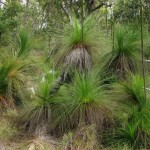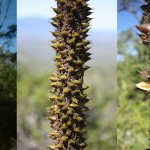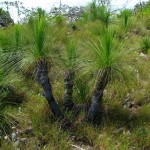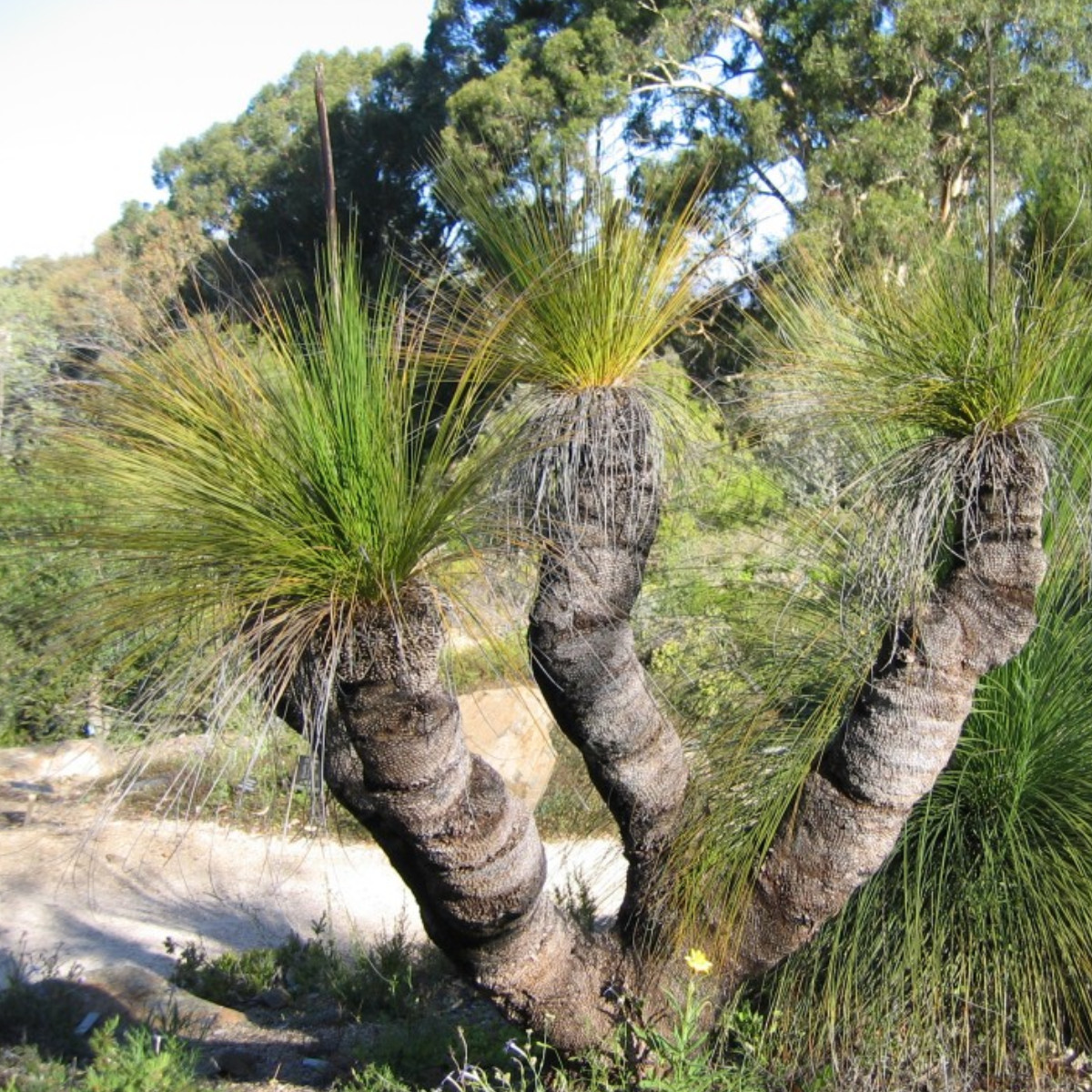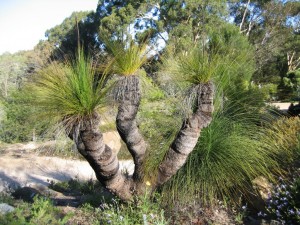Family: Xanthorrhoeaceae
Distribution and habitat: Xanthorrhoea johnsonii is endemic to Western Australia and grows naturally in sand, loam or gravelly soils (well-drained soils) in open forest and heath. It is a slow-growing perennial shrub with thick blackened trunks topped by a dense grassy clump of leaves. It takes decades to reach full maturity and can live up to 600 years.
These plants are often found growing on slopes or sides of hills. This indicates they like good drainage and will put up with poor rocky soil conditions.
Description: Xanthorrhoea johnsonii is a spectacular caudiciform plant whose spent leaf bases create a trunk, similar to that of a cycad. They are typically single trunked specimens that grow up to 4m (13 feet) tall, but rare multi-trunk specimens may occur. Minor changes in their trunk direction are usually caused by new growth after the tree flowers while major bends have been caused by accidents such as another tree falling on to the apex or pushing it over. Usually the tree will attempt to continue growing vertically. Every tree is unique and has years of history reflected in its shape. Xanthorrhoea johnsonii have a trunk that is typically black as a result of bush fires. The trunk is composed of a mass of old leaf bases held together by natural resin which can take 10 years before it begins to form. The centre of the trunk is filled with a fibrous material. During bushfires, the intense heat melts the natural resin in the trunk and this oozes out and solidifies.
Out of the trunk tops emerges a mass of long and thin but firm grass-like leaves, which extend 1m (3 feet) or so, arching over the trunk. The needle like foliage reduces moisture loss during periods of hot weather which makes the tree drought resistant.
The root system is shallow with the main purpose being for anchorage. Surrounding the roots are microbes called mycorrhiza fungi which are essential for nutrient uptake in deficient soils and also protect roots against some pathogen fungi.
In the wild it is rare for a tree under 80cm (31 inch) to produce a flower spike. In good soil though they can flower sooner and even produce more than one spike, which may then develop into more heads. The flowering stalk grows at a rate of 2-3cm (0.8-1 inch) a day, reaching a height of over 3m (10 feet). Honey-scented flowers normally appear in spring or after a fire and are white to cream on long spikes. Flowers are very attractive to birds, bees and butterflies and the tall woody flower spikes are a spectacular features.
Gardening: The rate of growth of Xanthorrhoea johnsonii is very slow (about 2.5cm (1 inch) per year). Once established these plants are extremely hardy, but can take few years for the plant to fully setting up and adapt.
Xanthorrhoea johnsoniigrow very well in containers. It makes a great feature that requires very little water and maintenance.
Remove fallen leaves and twigs from the foliage to prevent fungal infection. Its foliage can be trimmed back to 1/3 to 1/2 if it is brown of dry. This will encourage new growth.
As the flower spike is the active growth point for the tree, after flowering, it is natural for the tree to remain dormant and not produce new leaves for months or even years. Do not overwater or over fertilise as no assistance is needed. Burning the old growth in spring or summer can encourage the Xanthorrhoea johnsonii out of dormancy.
To encourage continuous growth remove the flower spike as soon as it appears and feed the leaves and roots with seaweed fertilisers.
Position: Xanthorrhoea johnsonii prefers full sun but will also tolerate part shade. Choose an open, sunny position for it.
Soil: Xanthorrhoea johnsonii will grow in well-drained soil. These plants do best in a native garden where the level of phosphorous is not raised. Avoid any boggy or low-lying spots that hold water during the wet season. If the soil is not suitable, then raised beds (1m (3 feet) high) filled with a free-draining soil mix will remedy the situation. Build the area up with sandy soil mixed with any medium that will provide bulk without nutrient such as gravel, rock, broken bricks, coarse sand or pebbles.
It will grow best in loam or sandy loam.
Xanthorrhoea johnsonii will always grow more vigorously in the garden than in pots as they can access the right balance of nutrients themselves.
When moving a grass tree from its pot, be extremely careful not to crack or disturb the roots. These trees do not have a strong network of roots to bind the soil around the plant. Active roots are black and fleshy, and can be easily damaged.
When planting into the ground, leave the plant in its pot and cut the base from the pot, keeping its walls intact. Place the plant in the hole burying it no deeper than the existing soil level, then cut the rim off the top of the pot.
Alternatively, cut the pot away from the root ball rather than attempting to remove it by knocking out the plant from its pot to not disturb the roots. Carefully place the plant in a hole which is larger than the root ball. Back fill and then water it in well to eliminate air pockets.
If creating a decorative potted feature with Xanthorrhoea johnsonii, choose a pot that is larger than the current one. Place large rocks, pebbeles, gravel or broken bricks into the bottom of the new pot to maintain good drainage between the two pots. Place the decorative pot on pot feet or similar for additional drainage. If desired, cut the rim of the plant pot away. Place theXanthorrhoea johnsonii into the decorative pot and complete with a large pebble mulch to add aesthetic appeal.
Water: If the tree is planted into the ground, give it a thorough watering whenever the soil is dry 5cm (2 inch) deep. If there is no rainfall, water the plant about once a week during the summer and about once every 10 days in spring and autumn.
If the tree is potted, water moderately allowing the top 5cm (2 inch) of potting mixture to dry out before watering again. Do not stand the pot on a saucer except in hot, dry conditions.
Even as young plants,Xanthorrhoea johnsonii are very tough and can handle drought & full sun.
Fertilising: In good soil no fertiliser will really be needed, however, feed the tree with slow release for Australian natives especially during flowering. Alternatively, feed the plant with diluted seaweed fertiliser to promote good foliage growth. Do not overfertilise the Xanthorrhoea johnsonii. As this species thrives in well drained, aerated soils that have a low nutrient content, it is not considered thatXanthorrhoea johnsonii will require fertilising.
Propagation: Xanthorrhoea johnsonii can be propagated from seed, as seed is easily collected and germinated. Seed pods can be collected when ripe and should be allowed to dry. The seeds are then removed from the pod and can be germinated in a free draining potting soil. A little coarse sand over the top of the seeds will keep them in contact with the potting mix. Keep moist, but do not over water. Seed is relatively easy to germinate without requiring pretreatment and can emerge within approximately 21 days, although it has been reported that seed can take up to a year to germinate. The seedlings are very slow to grow and, once established, require a well-drained, light or medium soil and a sunny position.
While they do grow slowly, quite attractive plants with short trunks (10 cm) and leaf crowns up to 1.5m (to the top of the leaves) can be achieved in 10 years. The slow growth rate means that it can take 30 years to achieve a specimen with a significant trunk.
Problems: A good indication to determine if the tree is to survive, is to pull gently at the centre needles. If they come away, this indicates the crown is rotting and unfortunately there is no remedy. In some cases burning the 'skirt' will promote growth as mentioned below.
The most common problems are with drainage, transplant shock or nutrient toxicity from excess application of chemical fertilisers.
If it looks unhealthy (browning, yellowing or showing lack of vigour), ensure the drainage is perfect, water with seaweed fertiliser or fish emulsion for 2 months in the growing season or until it looks happier. If the leaves are almost totally brown, try burning as much of the grass as possible and cut back the rest until it is bald. Mulch well, water weekly until the new grass is over 30cm.
Scale insects are sap-suckers which have either a waxy or armoured covering. Juvenile scales (crawlers) disperse to favourable sites on the leaf and start feeding. The crawlers eventually become immobile, and start building their protective covers, but are still sucking the needles. This activity, if left unchecked, may eventually kill the plant.
Treatment: Control scale with an application of white oil, but not during hot weather as this may burn the plant.
Mealybugs often have a number of overlapping generations per year. Their development is dependent on temperatures above 25C (77F) with high humidity. After hatching, the juveniles (crawlers) search for suitable feeding sites in sheltered areas.
Treatment: Control is best achieved in early spring at crawler stage with an adequate insecticide. Populations reach peaks during spring and autumn.
Xanthorrhoea johnsoniiare also susceptible to root attack by the Cinnamon Fungus (Phytophthora cinnamoni). This fungus attack can cause a gradual decline in health, eventually leading to death. Water spreads the fungus and it thrives where there is lots of moisture. Try to keep the garden free of extra moisture as there is no fungicide to combat this problem.
Setting fire to the crown:Contrary to popular belief, it is not necessary to set fire to Xanthorrhoea johnsonii at any stage of plant life, however in some situations can be relieving for the plant.
Flowering in nature occurs after a bushfire and in absence of fires, it will only flower in a good season or if they are very healthy plants. Setting fire to the crown is recommended as a method to control and combatbardi grubs infestation and may be helpful in controlling the crown rotting. Burning of excess of foliage every 3-4 years does little damage to the green crown, as it actually promotes growth as it would in a natural fire. The easiest method to burn the skirt is by placing a cardboard box filled with newspaper over the crown and setting fire. The foliage will burn and new foliage will develop after around 6 months.
Notes: Xanthorrhoea johnsonii is an iconic species in Australia. It occurs in fire-prone environments, it is very tolerant to fire and can recover from substantial damage. Fire tends to promote its reproductive capacity. The capacity to flower directly after a fire before most other species have time to recover not only ensures a food source for many insects and birds, it also increases the likelihood of frequent and successful pollination.It seams that not the heat, but the smoke is responsible for promoting this tree flowering. Seed-set rates of fire-affected populations can be very high, with up to 10,000 seed per flowering stem. Seed germination occurs around 612 months after fire. Seed production can be maximised by ensuring that plants are burnt during summer approximately every 6 years.
Xanthorrhoea johnsonii exhibit continuous although seasonally variable leaf growth, producing up to 3.2 leaves per day. Growth rates are greatest when daily average temperatures reach 20C (68F). Removal of the crown will increase leaf production; however, this will drop back over time. The leaves live about 2-2.8 years. When the leaves die they are not shed, and this causes a dead thatch of old leaves to form around the stem, which accumulates until burned by fire or lost through decay. Since the plants tend to store food reserves in the stem, the occasional removal of foliage can occur with little effect on the plant.
Uses: Xanthorrhoea johnsonii is an ideal choice for a courtyard, outdoor dining or entertainment area or around the pool. Rows of identical straight Xanthorrhoea johnsonii, like sentinels, are ideal in formal settings while varied gnarly Xanthorrhoea johnsonii are spectacular in bushland type landscapes. They look absolutely spectacular in paved court yards, rock garden beds, centre driveway positions.
These unique specimens compliment both formal and informal gardens. It suits mediterranean, oriental, contemporary, dry style, coastal or bush designs and can be used for pot, large planter, accents.
In the 1980s the foliage was established as a popular green filler for floral displays, along with the flower, in florist shop products.
Height: 4m (13 feet)
Width: 1.5m
Hardiness zone: 9b-11
